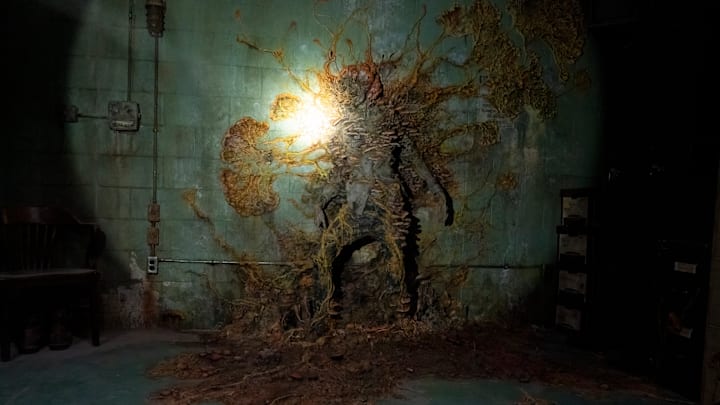In HBO’s new show The Last of Us—adapted from a 2013 video game of the same name—a mutated Cordyceps fungus has infected humanity, turning those unlucky enough to become hosts into clicking, screaming, mushroom-y monsters. Here’s what you need to know about the real life fungus behind the show ... including whether or not it could infect humans.
1. Its name might have something to do with its shape.

Cordyceps—the name given to a genus of fungus in 1818 by Swedish mycologist E.M. Fries—was created by combining the Ancient Greek word cordyle (κορδύλη), meaning “club,” with the Latin word for “head,” caput. According to the Oxford English Dictionary, this might be because of “the appearance of the fruiting bodies of these fungi, which have rounded ends and may be thought to resemble clubs.” There are more than 400 species in the Cordyceps genus, and they can be found in forests all over the world.
2. Cordyceps fungus usually infects insects ...
When they were creating The Last of Us video game, Neil Druckmann and Bruce Straley took inspiration from a nature documentary—specifically, the BBC’s Planet Earth, “where they talked about the [cordyceps] fungus and how it affects insects,” Druckmann told VentureBeat in 2013.
In general, Cordyceps are parasites. As mycology expert and Miami University Professor Nicholas P. Money explains in Fungi: A Very Short Introduction, “Insects and spiders are attacked by Cordyceps species that penetrate their exoskeletons, invade their soft tissues, and break out from the dead animal with club-shaped fruit bodies.”
But the more famous lifecycle that Druckmann and Straley were inspired by belongs to a Cordyceps cousin: Ophiocordyceps. An ant infected with spores of Ophiocordyceps unilateralis, National Geographic explains, will “leave its nest for a more humid microclimate that’s favorable to the fungus’s growth. The ant is compelled to descend to a vantage point about 10 inches off the ground, sink its jaws into a leaf vein on the north side of a plant, and wait for death.”
The fungus continues to grow, eating everything inside, until the insect finally dies—at which point the fruit of the fungus will burst out of the ant’s head, sending fresh spores out into the air in search of new ants to infect. This has probably existed for quite awhile: There’s evidence of the “death-grip” on a 48-million-year-old leaf fossil.
3. … But it isn’t capable of infecting humans.

The consensus among scientists seems to be that what Cordyceps does to humans in The Last of Us is something that would take millions of years to evolve, as the relationship between the fungus and insects has.
“Everything in the human body is so different from the insects that these fungi normally infect, including our physiology, our nervous tissue, and our body temperature,” mycologist and Utrecht University assistant professor Charissa de Bekker explained to Vox. “Even if the fungi were able to cause a small infection, the machinery that is needed for the fungus to do such a precise manipulation is simply not there. … We don’t see the fungi specialists just jumping from one ant species to another, let alone from an ant species to another insect. Spreading from ant to human is just such a big jump.”
That said, there are funguses that could prove dangerous to humans, like the relatively recently discovered Candida auris, a yeast that is resistant to many antifungal medicines and can cause serious chronic infections and even death.
4. Some species of Cordyceps are being investigated for medicinal properties.

Scientists are looking at various specifies of Cordyceps fungus for potential health benefits ranging from aiding in the management of type 2 diabetes to slowing the growth of tumors and cancer cells to alleviating inflammation. It’s even sometimes used in kidney transplants—though as with many Cordyceps medical claims, better evidence is needed before scientists can say if it actually has a benefit. Cordyceps militaris, which can be cultivated in a lab, is used in a number of health supplements.
It’s also believed that Cordyceps has performance-enhancing abilities; the fungus (or a related Ophiocordyceps) made news in 1993 when the coach of China’s women’s running team said his athletes—who broke several records at the World Championships in Athletics that year—had been taking the fungus.
5. An Ophiocordyceps species is one of the most expensive fungi in the world.

In parts of the Tibetan Plateau, Ophiocordyceps sinensis takes over the larvae of ghost moths. The caterpillar and its resulting fungal spore, known as Yartsa Gunbu (it also goes by a number of other transliterations, including Yarchagumba, and means “summer grass, winter worm”), is one of the rarest and most expensive fungi on Earth: According to some estimates it can cost around $20,000 for a just couple of pounds, leading to an apt nickname: Himalayan Gold. (According to a 2017 paper in the journal PNAS, “By 2017, high-quality pieces sold for more than 140,000 USD per kilogram in Beijing, more than three times the price of gold” at that time.) It’s often used in traditional Chinese medicine, and demand is so high that the fungus is now an endangered species (climate change and habitat degradation have also contributed to its endangered status). A dispute over it may have even led to murders in Nepal.
